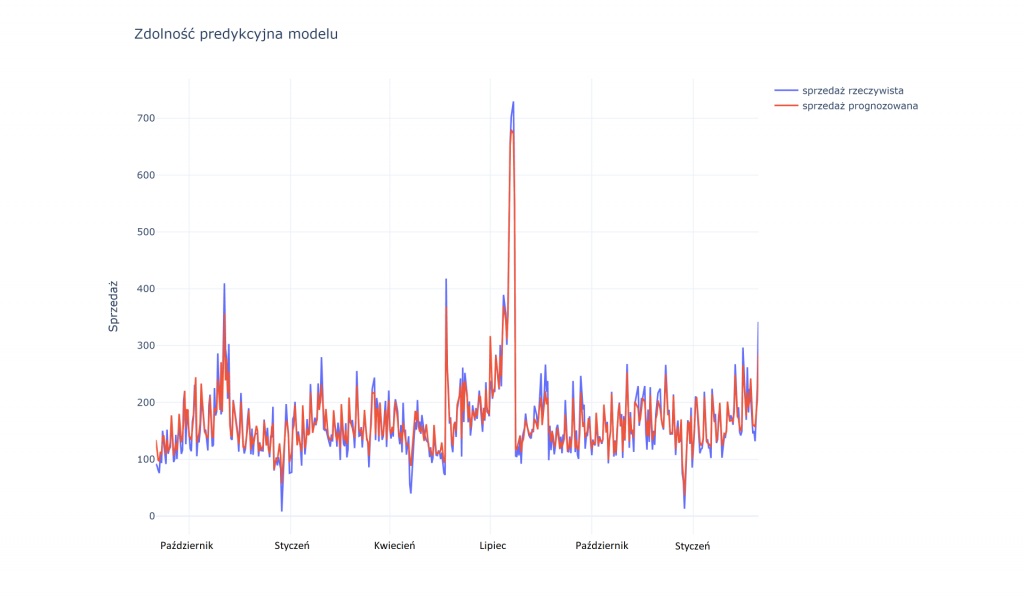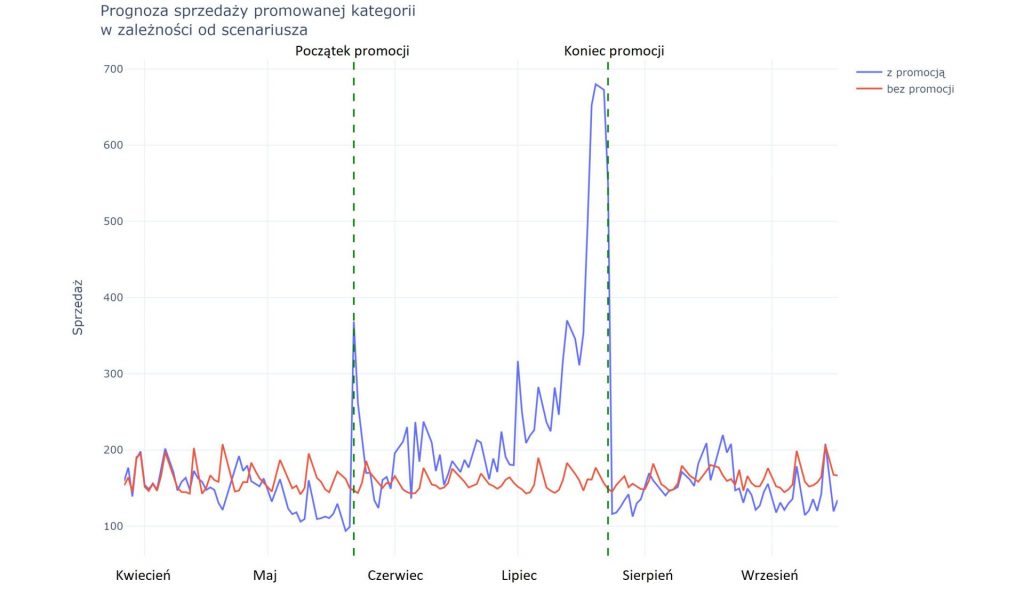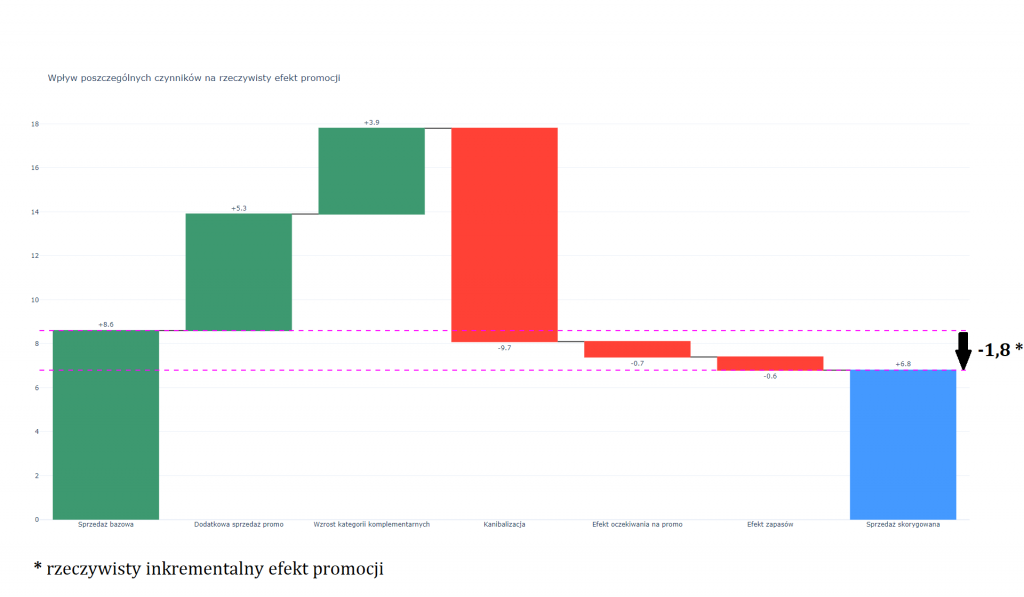Up to 80% of promotional campaigns do not bring any noticeable increase in sales or the cost of granted discounts is higher than the margin generated on additional turnover – proves a Boston Consulting Group study. The former can be abandoned without fear of lost sales. It is necessary to resign from the latter ones, because their financial effect is negative. Meanwhile, the strategy of many retailers is based on promotions. This applies to most industries. And what is more, it concerns both stationary channels and online trade. The pressure of competition, the fight for market share and consumer habits mean that the annual number of offers often runs into hundreds or even thousands. So the space for optimization is huge. But how to distinguish profitable promotions from those generating losses? How to measure the real effect of a promotion? Is it possible to predict the outcome of a promotion before it even starts? How can we better plan promotions?
Measuring the effect of a promotion
The key to success is to measure the effects. Without knowledge of the actual results of a promotion, managers are doomed to strategies such as copying the “proven” calendar of previous years, reacting to the actions of competitors or simply their own intuition. In theory, the task may seem simple. It is enough to compare sales during the promotional period with… Well, exactly… with what? Various possibilities come to mind: maybe sales before and after the promotion period? Maybe sales in the same period of previous years? How about excluding certain outlets from the promotion and using them as a comparison group?
However, demand for products is often seasonal and changes regardless of promotions. The previous year may have been different due to the macroeconomic situation or the entry of a new competitor into the market. Selecting a representative comparison group can be difficult, if not impossible, for online retail. Additionally, promotions overlap. Some are heavily advertised in the media, others only at the store shelf. The real business world is complex and overly simplistic methods of analysis can lead to incorrect conclusions.
With help come advanced methods of data science. Thanks to them, it is possible to develop a model that takes into account many factors influencing the effect of a promotion. From the assortment covered, through the amount of discount, additional conditions and mechanics, other concurrent campaigns, to the weather, advertising activity and actions of competitors. It is necessary to collect accurate data on historical promotions and their characteristics. A properly prepared model allows to isolate the influence of individual factors on sales. This enables understanding their impact, both for historical campaigns and predicting the effect of promotions yet to be planned.
The graph below shows the achievable prediction accuracy of the model. The blue line represents actual sales, while the red line represents sales predicted by the model. As you can see, both lines are very close to each other. In practice, it is impossible to avoid some deviations, especially visible on days with extremely high or low sales, but the model identifies trends and directions of changes very well.

Testing a promotion before it begins
A prepared model with adequate predictive capability allows to forecast sales depending on the date, duration, scope and nature of the promotion. This makes it possible to simulate various action scenarios and find answers to questions such as:
– will the promotion generate additional sales?
– what is the best period to conduct a promotion?
– what is the optimum duration of a promotion?
– what kind of communication support is worth providing for the promotion?
– Is it worth running the promotion, taking into consideration all effects?
The chart below shows a comparison of sales in the scenario assuming running the promotion (blue line) in comparison with the baseline scenario in which the promotion would be abandoned during the period under consideration (red line). It is clear that the blue line is above the red line for most of the duration of the promotion. Particularly large increases are seen at the end of the promotion period, as well as at the beginning. The timing of the promotion was clearly communicated to consumers in this case hence the accumulation of sales. In the scenario without the promotion, sales would be more evenly distributed with only a periodic weekly cycle visible. The average sales level, as the graph shows, would be lower. So it seems that promotion has a positive effect on sales and should be profitable. But is it really?

A comprehensive model of promotion
When evaluating the effects of a promotion, one should look not only at the sales increase, but also at other phenomena related to the promotion that would not occur if there was no promotion. It is primarily about the shift of sales in time (in the example visible in the period just before and just after promotion), as well as about the impact of promotion of a given assortment on other product categories. For complementary categories, we expect a positive impact on sales. However, for other categories (for example, non-promoted substitute products), the effect may be negative. It is the interaction between these different effects that determines the overall profitability of the promotion. It is therefore necessary to estimate them precisely. A model built and tested with the use of data science methods makes it possible.
The diagram below visualizes the decomposition – the breakdown of the total effect of a promotion into individual components. The base sale is the sale that would have been realized if there had been no promotion. The additional promo sales were estimated at 5.3 million using the model. This is how much more we sold of the products promoted by running the promotion.
Complementary category growth is the positive impact of the promotion on categories typically co-purchased with the promoted products. Cannibalization is the negative influence of a promotion on sales of other product categories – in this example it amounts to 9.7 million, thus cancelling out the entire positive effect of promotional activities. Additionally, effects related to the time shift in sales – before the campaign (the waiting effect) and after the campaign (the effect of buying on stock at lower prices) worsen the result of the action by another 1.3 million. After taking into account all the above-mentioned effects of the promotion, total sales were 6.8 million, i.e. 1.8 million less than in the scenario without the promotion. Therefore, the real incremental impact of the promotion on sales is negative, i.e. the promotion was not profitable.

Summary
In conclusion, a simplistic approach to promotion analysis and limiting itself to the effect of increased sales of promoted products during the promotion period may lead to incorrect conclusions and suboptimal decisions. Only a complex analysis based on a wide range of data and using advanced data science methods can answer the key questions from the point of view of promotion planning. Precise promotion models allow to accurately estimate particular effects, to accurately simulate alternative scenarios and to optimize not only single promotional campaigns, but the whole promotional calendar.

